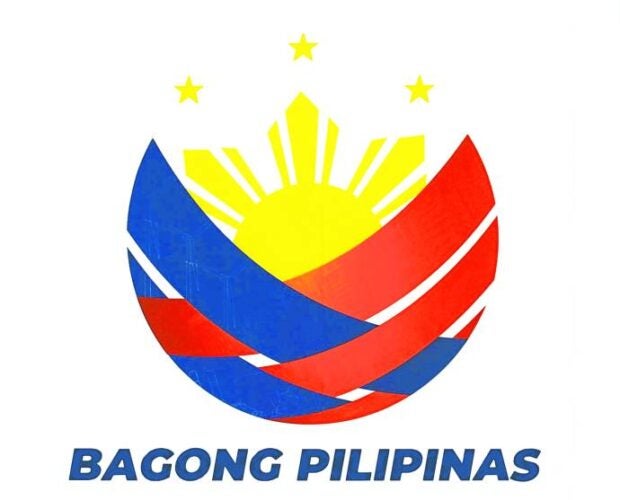
MANILA, Philippines — What was once a line from President Ferdinand Marcos Jr.’s 2022 election campaign ditty, “Bagong Pilipinas” (New Philippines) is now his administration’s governance theme or slogan, and it comes with what could be the mother of all government logos.
A presidential memorandum made public by Malacañang on Saturday directed that all government agencies, corporations, and state colleges and universities, be “guided by the principles, strategies and objectives of the Bagong Pilipinas brand of governance and leadership in planning their programs, activities and projects.”
It said that this “overarching theme” called for “deep and fundamental transformations in all sectors of society and government, and fosters the State’s commitment towards the attainment of comprehensive policy reforms and full economic recovery.”
As a “branding and communication strategy,” Bagong Pilipinas will be “characterized by principled, accountable and dependable government” pledged to help Filipinos reach their “goals and aspirations,” according to the July 3 Memorandum Circular No. 24.
It said that the accompanying logo would be in the letterheads, websites, official social media accounts, and other documents of all state agencies and entities.
Bagong Pilipinas is reminiscent of the Bagong Lipunan, or New Society, the period covered by the president’s father’s dictatorial rule from 1972 to 1986.“Bagong Pilipinas, Bagong Mukha (New Face)” was composed by Filipino rapper Andrew E and used to stir up the excitement of the massive crowds that attended Marcos’ campaign rallies.
The president himself recently used the phrase Bagong Pilipinas.
Following a trip to Japan in February this year, he said in his YouTube vlog, “The path to a New Philippines is clear as long as we lay the right foundation.”
Speaking in Filipino to express support for the LGBTQ+ community last month, he said that “in the New Philippines, the Filipino is broadminded and free from discrimination and ridicule.”
The soon-to-be ubiquitous logo is a round representation of the Philippine flag, where the lower half of the sun is partly covered by blue and red ribbons, with the three stars above it completing the circle.
On the blue ribbons could be seen faint images of power windmills, which could be found in the President’s home province of Ilocos Norte, a satellite, solar energy panels, a nuclear plant cooling tower and two smoke stacks that could represent power plants. Fainter images of buildings under construction are on the red ribbons.
The memorandum has not been uploaded on the website of the Official Gazette, the government’s official journal, as of Saturday evening.
Past sloganeering
Previous administrations also adopted their own government slogans.
Rodrigo Duterte had his “Change is Coming,” a vow to resolve the pressing problems of government corruption, criminality, illegal drugs, and the breakdown of law and order. It was coupled with the “Build! Build! Build!” infrastructure program.
Before Duterte was Benigno Aquino III’s “Daang Matuwid” — literally “Straight Path” — a mantra to usher an administration anchored on anticorruption and good government. Its accompanying slogan was “Kung walang korap, walang mahirap” (Without corruption, there will be no poverty).
His predecessor, Gloria Macapagal-Arroyo, rallied Filipinos around a “Strong Republic” to set its independence from “class and sectoral interests” and to build “strong institutions and a strong democracy, to execute sound policies and deliver essential public services.”
Joseph Estrada’s “Erap Para sa Mahirap” was short-lived as he was impeached less than halfway through his term on charges of bribery, graft, corruption, betrayal of public trust, and culpable violation of the Constitution.
The Fidel Ramos administration had “Philippines 2000,” supposedly a strategic framework for effective government and economic policies to transform the Philippines from a laggard to the “next Asian tiger economy.” The former general’s battle cry was “Kaya natin ’to!” (We can do it!).
Corazon Aquino, who was swept to power in the 1986 Edsa People Power Revolution, had no governance slogan that ran through her turbulent term, which was rocked by military uprisings and coup attempts while her government tried to lift the country out of severe economic decline. But she was able to get massive support for her call of “Tama na, sobra na, palitan na!” (We have had enough! It’s too much! Change it!”).
FM Sr.’s New Society
The president’s father and namesake’s New Society was a justification for the declaration of martial law in September 1972, a year before his second term was to expire, allowing him to continue to rule almost indefinitely.
The dictator said he imposed martial rule to “save the Republic” from the government’s enemies consisting of insurgents and right-wing oligarchs, and to “reform society” so that there would be no more poverty, hunger, corruption, and violence.
Renato Reyes, president of the martial law-era Bagong Alyansang Makabayan (Bayan) alliance which fought the dictatorship, sees a possible “revival” of the New Society.
“It will take more than rebranding to transform what has historically been a corrupt and moribund political system,” he said in a statement.
Reyes said that deeply rooted social problems required “more than a facelift, more than a slogan and a new logo” while corruption and political patronage remain.
“The Marcos regime is obsessed with rebranding and image-building, and not so much with problem-solving,” he said.
Deodorizer?
House Deputy Minority Leader France Castro said in a statement to the Inquirer that she and the two other Makabayan lawmakers will closely scrutinize the branding of the Marcos administration when Congress starts deliberation on the proposed 2024 national budget next month.
This is to “ensure the responsible use of public funds and to safeguard against the rewriting of history,” she said.
“What essentially is happening now is that the current administration is trying to deodorize the infamous Marcos dictatorship using the resources of the Filipino people,” she said.
“We must not forget the human rights abuses, corruption, and repression that characterized the Marcos regime. Any attempt to glorify or revise this dark period in our history must be met with vigilance and opposition,” Castro said.